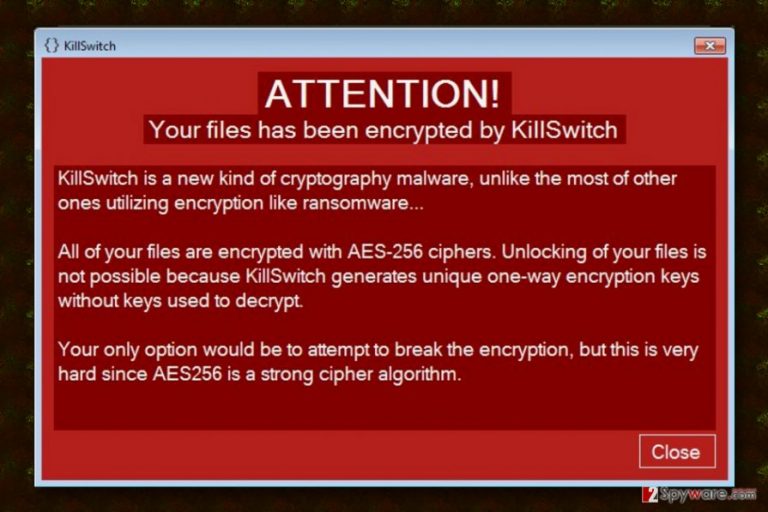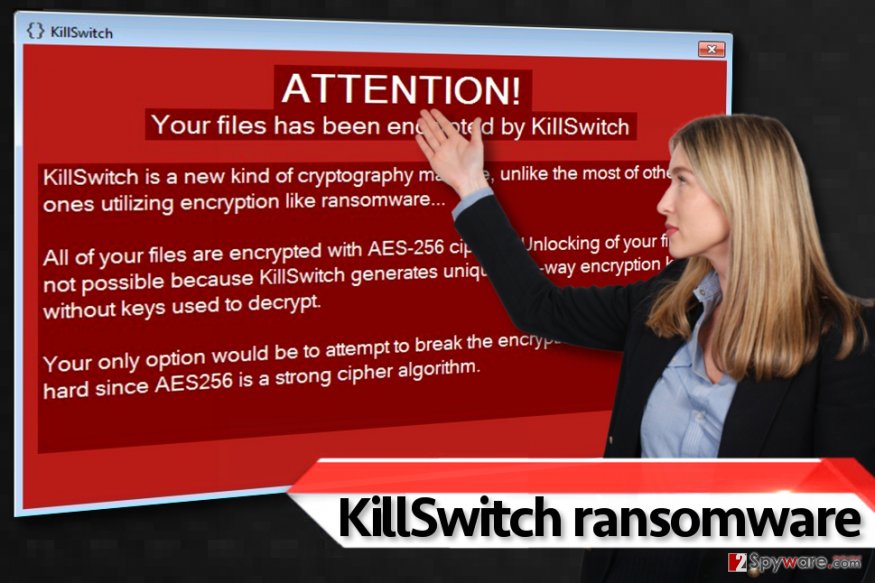KillSwitch ransomware / virus (Removal Guide) - Improved Instructions
KillSwitch virus Removal Guide
What is KillSwitch ransomware virus?
KillSwitch ransomware has no killswitch and is in development mode at the moment
KillSwitch virus is a hazardous ransomware created by someone who was probably inspired by the methods used by WannaCry ransomware. The authors of the ransomware named the executive file as CryptoKill.exe, probably to confuse the victims and make them search for information about CryptoKill virus online. The ransomware appears to be in development mode at the moment, meaning that the author of it is still testing and modifying this virus. At the moment, the virus only targets %USERPROFILE%\Documents\test\ folder (to encrypt files stored on it); however, this function can be easily changed to start encrypting all system folders. The virus is set to add .switch extensions to corrupted files. Once the virus finishes the encryption task, it then launches a red message that says:
Attention!
Your files has been encrypted by KillSwitch
KillSwitch is a new kind of cryptography malware, unlike the most of other ones utilizing encryption like ransomware…
All of your files are encrypted with AES-256 ciphers. Unlocking of your files is not possible because KillSwitch generates unique one-way encryption keys without keys used to decrypt.
Your only option would be to attempt to break the encryption, but this is very hard since AES246 is a strong cipher algorithm.

To begin with, statements provided in this message are utter nonsense and can only scare an inexperienced computer user. The described virus is a typical ransomware just like the others, just way less sophisticated. The ransomware was developed by an amateur programmer, and while at the moment it is not distributed on a global scale, you should take all possible ransomware prevention methods because in case your computer gets hit with more advanced ransomware such as Cerber[1], it won’t be possible to restore your files. If your files were corrupted by an updated variant of the described malware, remove KillSwitch ransomware using FortectIntego or Malwarebytes software and use data backup to restore encrypted files.
Distribution of file-encrypting viruses
Ransomware viruses are mostly distributed via malicious spam, infected ad networks or RDP[2]. Using an up-to-date anti-malware can prevent attackers from corrupting your files; however, it is important to be aware of ransomware and its distribution methods so that you could deflect malicious attempts to infect your system. We suggest you stay away from questionable messages that fall into your Inbox or Spam folder. Even if the email looks like its sent from a trustworthy person, do not open its attachments or links added to the message until you inspect sender’s email and realize that it is a real/trustworthy one. Remember that no legitimate companies allow their employees send emails from personal emails. On top of that, avoid visiting suspicious websites, especially those that provide adult/gambling content or illegal software download links.

Remove KillSwitch ransomware with ease
You can easily remove KillSwitch virus with the help of anti-malware software. However, to launch it, you will need to run your computer in Safe Mode with Networking. We have provided an easy-to-follow removal tutorial for those who have never tried to reboot PC in the aforementioned mode or never had a confrontation with malware. We do not recommend you to try to complete KillSwitch removal manually because ransomware is not a typical program and it can be very hard to remove all of its components at the same time.
Getting rid of KillSwitch virus. Follow these steps
Manual removal using Safe Mode
Kill the ransomware virus using these instructions. Firstly, reboot the PC into the proper mode and then delete the virus using a powerful anti-malware tool.
Important! →
Manual removal guide might be too complicated for regular computer users. It requires advanced IT knowledge to be performed correctly (if vital system files are removed or damaged, it might result in full Windows compromise), and it also might take hours to complete. Therefore, we highly advise using the automatic method provided above instead.
Step 1. Access Safe Mode with Networking
Manual malware removal should be best performed in the Safe Mode environment.
Windows 7 / Vista / XP
- Click Start > Shutdown > Restart > OK.
- When your computer becomes active, start pressing F8 button (if that does not work, try F2, F12, Del, etc. – it all depends on your motherboard model) multiple times until you see the Advanced Boot Options window.
- Select Safe Mode with Networking from the list.

Windows 10 / Windows 8
- Right-click on Start button and select Settings.

- Scroll down to pick Update & Security.

- On the left side of the window, pick Recovery.
- Now scroll down to find Advanced Startup section.
- Click Restart now.

- Select Troubleshoot.

- Go to Advanced options.

- Select Startup Settings.

- Press Restart.
- Now press 5 or click 5) Enable Safe Mode with Networking.

Step 2. Shut down suspicious processes
Windows Task Manager is a useful tool that shows all the processes running in the background. If malware is running a process, you need to shut it down:
- Press Ctrl + Shift + Esc on your keyboard to open Windows Task Manager.
- Click on More details.

- Scroll down to Background processes section, and look for anything suspicious.
- Right-click and select Open file location.

- Go back to the process, right-click and pick End Task.

- Delete the contents of the malicious folder.
Step 3. Check program Startup
- Press Ctrl + Shift + Esc on your keyboard to open Windows Task Manager.
- Go to Startup tab.
- Right-click on the suspicious program and pick Disable.

Step 4. Delete virus files
Malware-related files can be found in various places within your computer. Here are instructions that could help you find them:
- Type in Disk Cleanup in Windows search and press Enter.

- Select the drive you want to clean (C: is your main drive by default and is likely to be the one that has malicious files in).
- Scroll through the Files to delete list and select the following:
Temporary Internet Files
Downloads
Recycle Bin
Temporary files - Pick Clean up system files.

- You can also look for other malicious files hidden in the following folders (type these entries in Windows Search and press Enter):
%AppData%
%LocalAppData%
%ProgramData%
%WinDir%
After you are finished, reboot the PC in normal mode.
Remove KillSwitch using System Restore
-
Step 1: Reboot your computer to Safe Mode with Command Prompt
Windows 7 / Vista / XP- Click Start → Shutdown → Restart → OK.
- When your computer becomes active, start pressing F8 multiple times until you see the Advanced Boot Options window.
-
Select Command Prompt from the list

Windows 10 / Windows 8- Press the Power button at the Windows login screen. Now press and hold Shift, which is on your keyboard, and click Restart..
- Now select Troubleshoot → Advanced options → Startup Settings and finally press Restart.
-
Once your computer becomes active, select Enable Safe Mode with Command Prompt in Startup Settings window.

-
Step 2: Restore your system files and settings
-
Once the Command Prompt window shows up, enter cd restore and click Enter.

-
Now type rstrui.exe and press Enter again..

-
When a new window shows up, click Next and select your restore point that is prior the infiltration of KillSwitch. After doing that, click Next.


-
Now click Yes to start system restore.

-
Once the Command Prompt window shows up, enter cd restore and click Enter.
Bonus: Recover your data
Guide which is presented above is supposed to help you remove KillSwitch from your computer. To recover your encrypted files, we recommend using a detailed guide prepared by 2-spyware.com security experts.If your files were corrupted by Kill Switch ransomware, use a data backup to recover your files. However, if you do not have a backup, you can try to restore files using one of the provided techniques.
If your files are encrypted by KillSwitch, you can use several methods to restore them:
Restore files with Data Recovery Pro
Let Data Recovery Pro scan your computer to detect encrypted files and try to restore them.
- Download Data Recovery Pro;
- Follow the steps of Data Recovery Setup and install the program on your computer;
- Launch it and scan your computer for files encrypted by KillSwitch ransomware;
- Restore them.
Find Volume Shadow Copies
You can try to recover files using Volume Shadow Copies (in case the virus did not delete it). ShadowExplorer can find these copies and use them to restore your files.
- Download Shadow Explorer (http://shadowexplorer.com/);
- Follow a Shadow Explorer Setup Wizard and install this application on your computer;
- Launch the program and go through the drop down menu on the top left corner to select the disk of your encrypted data. Check what folders are there;
- Right-click on the folder you want to restore and select “Export”. You can also select where you want it to be stored.
Finally, you should always think about the protection of crypto-ransomwares. In order to protect your computer from KillSwitch and other ransomwares, use a reputable anti-spyware, such as FortectIntego, SpyHunter 5Combo Cleaner or Malwarebytes
How to prevent from getting ransomware
Stream videos without limitations, no matter where you are
There are multiple parties that could find out almost anything about you by checking your online activity. While this is highly unlikely, advertisers and tech companies are constantly tracking you online. The first step to privacy should be a secure browser that focuses on tracker reduction to a minimum.
Even if you employ a secure browser, you will not be able to access websites that are restricted due to local government laws or other reasons. In other words, you may not be able to stream Disney+ or US-based Netflix in some countries. To bypass these restrictions, you can employ a powerful Private Internet Access VPN, which provides dedicated servers for torrenting and streaming, not slowing you down in the process.
Data backups are important – recover your lost files
Ransomware is one of the biggest threats to personal data. Once it is executed on a machine, it launches a sophisticated encryption algorithm that locks all your files, although it does not destroy them. The most common misconception is that anti-malware software can return files to their previous states. This is not true, however, and data remains locked after the malicious payload is deleted.
While regular data backups are the only secure method to recover your files after a ransomware attack, tools such as Data Recovery Pro can also be effective and restore at least some of your lost data.
- ^ Jai Vijayan. Cerber Ransomware Now Evades Machine Learning. Dark Reading. Cyber security's Comprehensive News Site.
- ^ Jay Yaneza. Brute Force RDP Attacks Plant CRYSIS Ransomware. Trend Micro Blogs. Simply Security News, Views and Opinions.







